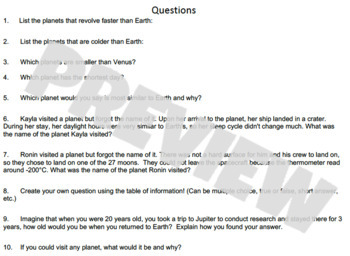Planets Lesson
Kreations with Katie
28 Followers
Grade Levels
3rd - 10th
Subjects
Resource Type
Standards
NGSSMS-ESS1-2
NGSSMS-ESS1-3
Formats Included
- Google Docs™
Pages
5 pages
Kreations with Katie
28 Followers

Made for Google Drive™
This resource can be used by students on Google Drive or Google Classroom. To access this resource, you’ll need to allow TPT to add it to your Google Drive. See our FAQ and Privacy Policy for more information.
Description
I created this exploration lesson to teach my students about the 8 planets in our solar system. It fosters scientific skills of analyzing data from a chart, and also incorporates mathematics with temperature conversions and addition of years of travel to different planets. This lesson includes:
- A Planet Information Date Table Word/Google Doc . This chart includes data for the planets diameter, rotation period, revolution period, average temperature, surface composition, rings, moons, and my students favorite- the average time it takes to get there from Earth!
- 10 analysis-based questions related to the Planet Information Chart on the first page
- Answer Key
Enjoy!
Katie
Total Pages
5 pages
Answer Key
Included
Teaching Duration
N/A
Report this resource to TPT
Reported resources will be reviewed by our team. Report this resource to let us know if this resource violates TPT’s content guidelines.
Standards
to see state-specific standards (only available in the US).
NGSSMS-ESS1-2
Develop and use a model to describe the role of gravity in the motions within galaxies and the solar system. Emphasis for the model is on gravity as the force that holds together the solar system and Milky Way galaxy and controls orbital motions within them. Examples of models can be physical (such as the analogy of distance along a football field or computer visualizations of elliptical orbits) or conceptual (such as mathematical proportions relative to the size of familiar objects such as students’ school or state). Assessment does not include Kepler’s Laws of orbital motion or the apparent retrograde motion of the planets as viewed from Earth.
NGSSMS-ESS1-3
Analyze and interpret data to determine scale properties of objects in the solar system. Emphasis is on the analysis of data from Earth-based instruments, space-based telescopes, and spacecraft to determine similarities and differences among solar system objects. Examples of scale properties include the sizes of an object’s layers (such as crust and atmosphere), surface features (such as volcanoes), and orbital radius. Examples of data include statistical information, drawings and photographs, and models. Assessment does not include recalling facts about properties of the planets and other solar system bodies.




